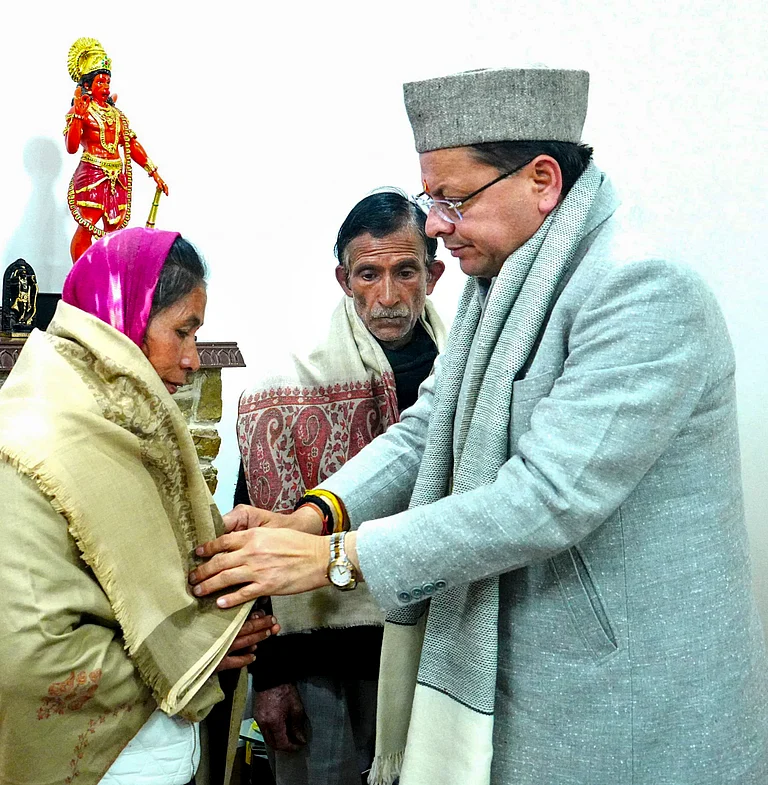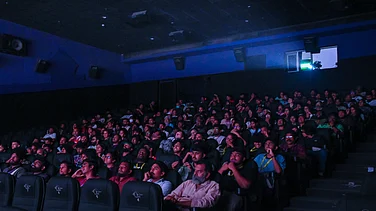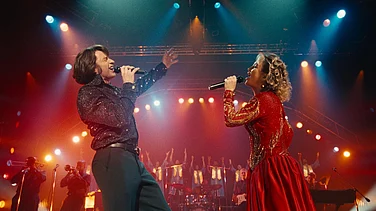Over the last 15 years, with the advent of digital cinema, the possibilities for cinematographers to engage with technology both at the higher and lower ends have exponentially increased. Not that such options were not available during the last century of celluloid-based cinema. For instance, the iconic Indian cinematographer, K K Mahajan, worked with directors ranging from Mani Kaul and Kumar Shahani to Mrinal Sen and Kalpana Lajmi, and Ravi Tandon and Ramesh Sippy. But what has changed is how the democratisation of the digital and affordances of technology have enabled the ‘look’ needed for a particular kind of narrative where budgets do not restrict the realisation of a scene, whether it be the finesse of camera angles, movements or lighting. For instance, aerial shots through drones are not exclusive to big films with stars, just as horizontal moving shots with a DSLR camera mounted on a gimbal enable the steadicam aesthetics of stabilised hand-held shots for indie productions at the lower end. Similarly, GoPro cameras mounted on mobile bodies and the use and insertions of shots, with DSLR cameras, like Sony A7S, particularly during action sequences or in enclosed/constrictive spaces without much light, are ubiquitous across the spectrum. Technology has enabled the shooting of night sequences with minimal light without grains.
The other significant change springs from the discourse surrounding the loss of the indexical with the digital, unlike in the case of the film, where it was accepted as proof in courts regarding the presence of objects and events during the last century. Now you can have smoke without fire, to borrow the lines of V K Murthy, Guru Dutt’s legendary cinematographer. You can multiply the number of birds in the sky seamlessly between what has been simulated as computer-generated images and what was present in front of the camera. The discourse, thus, is more focused on enhanced realism with the digital rather than the loss of reality, like the birds in Majid Majidi’s Beyond the Clouds, for instance, with cinematographer Anil Mehta. Unlike his national award-winning classical and ornate cinematography for Hum Dil De Chuke Sanam (1999), Beyond the Clouds privileged a gritty realism through texture and the use of restrictive and claustrophobic spaces, like the crowded Dhobi Ghat or the narrow Chor Bazaar, enabled by the minimal requirements regarding lights and the related spaces to mount them.
In contrast, Sudeep Chatterjee focused on the aesthetics of excess—stylised shafts of lights in the form of angled beams in Guzaarish (2010), recalling Murthy’s iconic cinematography in Kagaz Ke Phool (1959). With most scenes taking place in the interiors of the home of its quadriplegic protagonist, Chatterjee found a way for an expansive and profound exploration of space and emotions by juxtaposing beams with differing intensities. If Dhoom 3 (2013) marked the frenetic high-end side of Chatterjee, Drishtikone (2018) announces the coexistence of the other end of his oeuvre. Chatterjee’s investment in striking compositions and colors comes to the fore in this dramatic thriller shot with a modest budget. The marked use of blue, green and red is synthesised into white toward the end, when the knots are untied. The daring use of such colours is predicated on the control you have now during post-production regarding the plasticity of colour to seamlessly flow or interrupt as you need it.
At the other end is Bajirao Mastani (2015), which foregrounds Chatterjee’s preeminent status as a cinematographer, continuing the legacy of the studio era legends of the past. Through Bajirao Mastani, Chatterjee pays homage to Mughal-e-Azam and its veteran cinematographer R D Mathur. The song ‘Mohe Rang Do Laal,’ while invoking ‘Mohe Panghat Pe’ from Mughal e Azam, punctuates the potential for layering, where the decked-up Amber Palace in Rajasthan is meticulously composited with the palatial backdrop and the painterly skies along with the expanse on the sides of the fountainous and constructed set. Layering during postproduction thus becomes as important, if not more, than the attention paid to shooting on sets with green screen and informed production design. Similarly, the Aaina Mahal emulates the Sheesh Mahal of K Asif’s magnum opus. But the cherry on the cake is the meticulous way the dancing Mastani, played by Deepika Padukone, could be scaled digitally onto the reflecting acrylic mirrors on the ceiling. While the challenges of the camera getting reflected, as discussed by R D Mathur, is not a problem in these times of the easy additive and subtractive possibilities of the digital, the issue of overcoming the flatness of mirrors with lights remains. In this case, it was solved by using string lights or ‘mirchi lights.’ No doubt, Sanjay Leela Bhansali’s nostalgia for the classical studio era, production design, and music played major roles. However, it was Chatterjee’s play with warm and blue tones, particularly towards the end, with the increasing isolation/alienation of Bajirao that marked the distinctiveness of the film.
A similar play with the warm intimacy of the three working women staying together contrasting with the big city blues of the metropolis of Delhi marked the cinematography of Avik Mukhopadhyay in Pink (2016). Though the second half of the film is a courtroom drama contained within a set, the expansive anxieties of the urban space through intruding flashbacks, meticulously framed and lit, shed light on the capital of patriarchy, misogyny, and perversion. In an earlier era, straddling between indoors and outdoors or between the tungsten and blue lights of the HMI, evoking the exterior was cumbersome, expensive and limited by the capacity of lights and their wattage, restricting their usage to big-budget films, particularly when it involved covering large swathes of land.
Imagine covering the vast terrain of the region around the square of a village at night or when the protagonist of NH10 (2015), the avenging woman from the city, Meera, responds to the coterie of cold-blooded honour killers in a brutal village. Arvind Kannabiran, the cinematographer, drew attention to the multiple dino lights he could mount on a box to illuminate almost a kilometre of such a vast space. The digital look is predicated not just on technology but also on the works of gaffers, riggers, light people, and other technicians, the unsung heroes behind the cinematic image.

In contrast, Mehta shot Highway (2014), whose narrative revolves around the journey of its protagonist—an abducted woman—and her adventures and eventual liberation. As the narrative takes us through many small towns and villages on the way, reflexively, it informs us of the spaces away from the city and studio interiors made visible by the digital due to its sheer economy of lights, as its sensors are guided by the ‘Less is More’ principle, unlike the feudality of the celluloid that privileges exclusivity. Mehta uses bulbs and tube lights as practicals or sources and effectively frames the graffiti and changing textures as we move through this eventful journey with the luminous Alia Bhatt and her kidnapper. The increasing presence of suburban and the ‘ruburban’—the spaces between the rural and urban—and villages in contemporary Indian cinema is ubiquitous not only in Hindi but in regional cinemas and web series as well, such as in Attakathi (2012), Masaan (2015), Sairat (2016), Kumbalangi Nights (2019), and Panchayat (2020), to name a few. Nevertheless, such a digital utopia is also undermined by digital capitalism, where cameras are dumped as consumer products continually, simultaneously increasing the paraphernalia and the cost associated with high-end work, extending the budget beyond the imaginable. While the gaps have closed regarding latitude or the dynamic range between film, with differences becoming unidentifiable to the naked eye.
Unlike the stylised Chatterjee and his aesthetics of excess, Mukhopadhyay’s preoccupation with realism in a digital context is showcased among his many works, in Sardar Udham (2021). The muted colours in the film evoke the unjust and disconsolate past, while also contributing to the undermining of ideology, loss and repression leading to a cathartic climax that invites you to reflect on Udham Singh’s lesser-known and discussed history due to his displacement. Mukhopadhyay’s aesthetics leads us to meditate on his predicament rather than showcase London as a colorful space tinted by nostalgia for a rich past, as in a Merchant Ivory film or a romantic travel destination in Dilwale Dulhaniya Le Jayenge (1995). In a similar vein, one could read the profound use of yellow for the balmy but disgusting subterranean locale where the elusive treasure is stored and the eerie and sweeping exterior, washed in a cold blue in Tummbad (2018), shot by the pathbreaking Pankaj Kumar. Consider, for instance, the boat on the mysterious river with fire on the water in the background. Kumar, too, has straddled the spectrum with technology and scale from indie to big-budget films like Ship of Theseus (2012) to Haider (2014).
However, the most visible and remarkable intervention of the digital is the increasing number of prodigiously talented women filmmakers and cinematographers, apart from editors. No more can they be kept out, citing unscientific and unjust excuses, like the heaviness of the equipment involved. My heart goes out to Fowzia Fathima, the award-winning cinematographer of mainstream films like Whistle (2003) and Uyir (2006), who broke the glass ceiling with Mitr, My Friend (2002), directed by Revathi two decades ago. She is now ready with her recent digitally shot film, the highly anticipated Qadeesho, the Sacred, directed by her longtime collaborator and artist par excellence, Pradeep Cherian. The Indian Women Cinematographers Collective informs us of the history, intervention, and increasing presence of women cinematographers in Indian cinema. For instance, the pioneering B R Vijayalakshmi, with her films Chinna Veedu (1985) and Aruvadai Naal (1986) set the trend and paved the way for younger women. The future holds promise for pushing the limits of the digital as it enters the hands of women.
(This appeared in the print edition as "A Visual Explosion")
(The author thanks the cinematographers, particularly Ashwini Kaul, Fowzia Fathima and Naresh Sharma, for their inputs.)
Swarnavel Eswaran is an associate professor in the departments of English (Film Studies) and Journalism at Michigan State University.























